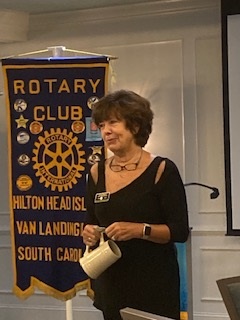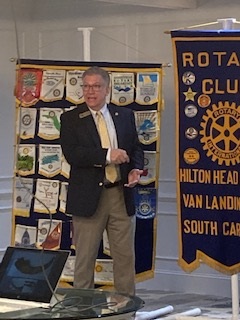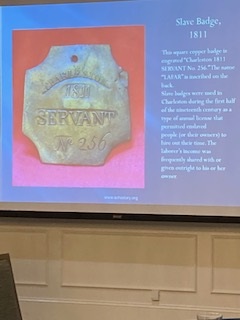President Kristin Keller called the meeting to order.
Ray Warco offered the prayer and led the pledge to the flag.
Announcements:
The August 31 meeting will be off site at the Solicitor's Office in Okatie.
September 4 Oyster Reef project
September 4 Frances Ferene Memorial
First social originally scheduled for September 13 has been moved to October 18. Watch for more details.

Past President Lynn King filled in for Sergeant at Arms Suzi Oliver and collected Happy $$
Speaker-
Kristin introduced speaker Scott Stephens, Vice President of Development of the South Carolina Historical Society.

The SC Historical Society was established in 1855. Its mission is "to expand, preserve and make accessible our collection; to improve knowledge of and encourage focus, interest and pride in the history of our state". The first president of the society was an ardent unionist, and one of the big voices of staying in the union. SC was being over looked in the history of the nation and so he wanted to focus on it's part in the nation. Henry Laurens 1724 - 1792 was, among other things, minister to Holland. Eliza Pinckney at the age of 16 took over her father's plantations. She found a strain of indigo that would grow here as well as in the upstate and SC became the third largest exporter of indigo. The state flag background is the color of indigo. Robert Mills was the best known architect in the state at the time. His works include two Washington Monuments as well as the Fireproof Building in Charleston which was built to protect documents. The museum today contains 3,000 collections, maps, and other historical items.

The photo above shows the Fort Walker Flag, which was taken as a prize and has pieces missing which were taken by the soldiers. Next to it is the Secession Banner which was flown in front of homes that wanted to leave the union. Another interesting fact that Mr. Stephens talked about was that in the mid 1700s the Capital of SC was in Charleston. There are many maps in the museum and we heard how the borders were determined and that there are still disputes with Georgia over the boundary of the Savannah River and the Islands within.

In 1811, Slave badges were given to slaves when they were rented or loaned out. In 1867 was the SC legislation Reconstruction, there were 50 from the north, 50 African Americans, of which only 8 who knew how to read or write participating. Steve presented so much fascinating information about our state, but you can learn even more by visiting the museum or their website: www.schistory.org